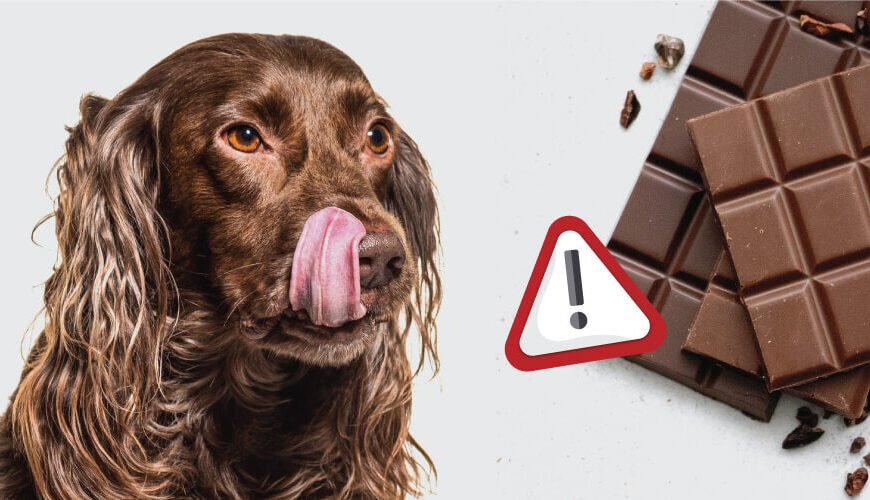Introduction: Can dogs eat chocolate?
As a dog owner, it’s important to educate yourself about the foods that are safe and harmful for your furry friend. One of the most common questions that arise is whether dogs can eat chocolate. The short and straightforward answer is no, dogs should not eat chocolate. But why is chocolate harmful to dogs? In this article, I will delve into the dangers and risks associated with dogs consuming chocolate, the symptoms of chocolate poisoning, factors that influence its severity, and what you should do if your dog happens to ingest chocolate.
The dangers of chocolate for dogs
Chocolate contains a compound called theobromine, which is toxic to dogs. While humans can easily metabolize theobromine, dogs lack the necessary enzymes to break it down effectively. As a result, the theobromine builds up in their system, leading to various health issues. Dark chocolate and cocoa powder have higher concentrations of theobromine, making them more dangerous for dogs compared to milk chocolate.
When a dog consumes chocolate, it can cause a range of symptoms such as vomiting, diarrhea, increased heart rate, restlessness, muscle tremors, and even seizures. In severe cases, chocolate poisoning can be fatal. It is crucial to be aware of these dangers and take immediate action if your dog ingests chocolate.
Why is Chocolate Toxic to Dogs?
Unlike humans, who can efficiently process theobromine, a stimulant found in cocoa, dogs lack the necessary enzymes. This leads to a buildup of theobromine in their system, which can cause a range of health problems. The severity of the reaction depends on several factors, including:
- The type of chocolate: Dark chocolate, with its higher theobromine concentration, is significantly more dangerous than milk chocolate or white chocolate.
- The amount consumed: Even a small amount of dark chocolate can be harmful to a small dog, while a larger dog might require a larger quantity to experience negative effects.
- The size of the dog: Smaller dogs are generally more susceptible due to their lower body mass.
Common symptoms of chocolate poisoning in dogs
The signs of chocolate poisoning in dogs can vary depending on the amount of theobromine ingested. Early symptoms might include:
- Vomiting
- Diarrhea
- Excessive thirst and urination
- Hyperactivity or restlessness
As the poisoning progresses, more severe symptoms may arise, such as:
- Tremors
- Seizures
- Rapid heart rate or abnormal breathing
- Internal bleeding
- Coma
- In extreme cases, chocolate poisoning can be fatal.
Long-Term Consequences: Beyond the Immediate Threat
Even if your dog recovers from the initial effects of chocolate poisoning, there’s a possibility of long-term health complications. These can include:
- Kidney damage
- Cardiac arrhythmias
- Neurological deficits
Treatment Strategies: Responding to Chocolate Ingestion
If you suspect your dog has eaten chocolate, immediate action is crucial. Contact your veterinarian or the nearest emergency animal clinic without delay. Do not wait for symptoms to appear, as early intervention is vital for improving the prognosis. Treatment typically involves:
- Decontamination: Inducing vomiting or administering activated charcoal to remove unabsorbed theobromine from the stomach.
- Supportive care: Providing intravenous fluids to address dehydration and electrolyte imbalances, monitoring vital signs, and administering medications as needed.
What to do if your dog eats chocolate
If you catch your dog eating chocolate or suspect they have consumed it, it’s essential to take immediate action. First, try to determine the amount and type of chocolate your dog has ingested. This information will be helpful for your veterinarian in assessing the potential risk and severity of chocolate poisoning.
Contact your veterinarian immediately and provide them with all the necessary information. They will guide you on the next steps to take based on your dog’s size, the amount of chocolate consumed, and the time that has elapsed since ingestion. In some cases, inducing vomiting may be necessary, while in others, your veterinarian may recommend monitoring your dog closely for any symptoms.
Prevention is Key: Safeguarding Your Dog from Chocolate
The best way to protect your dog from the dangers of chocolate is through prevention. Here are some essential steps you can take:
- Store all chocolate products securely, out of reach of your dog.
- Never share human treats containing chocolate, regardless of the amount.
- Be mindful of hidden chocolate in baked goods, cocoa powder, and baking dough.
- Educate family members and friends about the dangers of chocolate for dogs.
Chocolate Alternatives for Your Dog: Spoil Them Safely!
Who says your dog can’t indulge in delicious treats? While chocolate is strictly off-limits, there are plenty of safe and satisfying alternatives to keep your furry friend happy and healthy. Here are some pawsome options:
1. Dog-approved treats: Pet stores and online retailers offer a wide variety of treats specifically formulated for dogs. Look for treats made with natural ingredients like fruits, vegetables, and whole grains.
2. Frozen fruits and vegetables: Many fruits and vegetables, like bananas, apples (core removed), blueberries, and carrots, are safe and refreshing options for your dog. Simply chop them into bite-sized pieces and freeze them for a cool and crunchy treat.
3. Homemade dog biscuits: Baking your own dog treats allows you to control the ingredients and ensure they are free of harmful additives. Look for dog-friendly recipes online and get creative in the kitchen!
4. Stuffed Kong toys: Fill a Kong toy with peanut butter, mashed banana, or yogurt (plain, unsweetened) and freeze it. This provides mental stimulation and a long-lasting treat for your dog to enjoy.
5. Chewing toys: Safe and appropriate chew toys help satisfy your dog’s natural chewing instincts, keep them occupied, and promote dental health. Choose durable toys made from materials like rubber or nylon.
Remember, moderation is key even with these safe alternatives. Always consult your veterinarian before introducing any new food to your dog’s diet, especially if they have any allergies or health concerns.
By providing your dog with safe and healthy alternatives, you can show them love and appreciation without compromising their well-being. Remember, a happy and healthy pup is a reward in itself!
Myths and Misconception About Dogs and Chocolate:
While awareness about chocolate toxicity is growing, several myths and misconceptions persist. Let’s address some of the most common ones:
Myth 1: Baking chocolate is the only dangerous type.
Fact: While baking chocolate has the highest theobromine concentration, all types of chocolate, including milk chocolate and white chocolate, can be harmful to dogs.
Myth 2: A small amount of chocolate won’t hurt.
Fact: Even a small amount of chocolate can be dangerous, especially for smaller dogs. It’s crucial to avoid giving your dog any chocolate, regardless of the quantity.
Myth 3: My dog ate chocolate before and seemed fine.
Fact: Every dog reacts differently to theobromine. Just because your dog didn’t experience any negative effects in the past doesn’t guarantee it’s safe in the future. It’s always better to err on the side of caution and seek veterinary help immediately if chocolate ingestion is suspected.
Myth 4: Giving my dog milk will counteract the effects of chocolate.
Fact: Milk can actually worsen the situation by promoting theobromine absorption. If you suspect chocolate poisoning, never attempt home remedies and consult a veterinarian immediately.
Myth 5: Making my dog vomit will get rid of the chocolate.
Fact: While inducing vomiting can be helpful in certain cases under professional guidance, it’s not always recommended and can be dangerous in some situations. Leave the decision to induce vomiting to your veterinarian.
Remember, when it comes to chocolate and your dog, it’s never worth taking a chance. By understanding the facts, dispelling myths, and prioritizing prevention, you can ensure your furry companion enjoys a safe and chocolate-free life.
Conclusion: Can Dogs Eat Chocolate?
In conclusion, dogs should never eat chocolate due to its toxicity. Theobromine, the compound found in chocolate, can cause various health issues in dogs, ranging from mild symptoms to life-threatening conditions. It’s crucial to be aware of the dangers of chocolate and take preventative measures to keep your dog safe.
If your dog happens to ingest chocolate, contact your veterinarian immediately. They will guide you on the necessary steps to take based on your dog’s size, the amount of chocolate consumed, and the time that has passed since ingestion. Remember, prevention is key, so always keep chocolate and other harmful substances out of your dog’s reach.
By understanding the risks associated with dogs eating chocolate and taking proper precautions, you can ensure the well-being and safety of your furry friend. Keep your dog healthy and happy by providing them with dog-friendly treats that are safe and delicious.
CTA: Ensure the safety of your furry friend by spreading awareness about the dangers of chocolate for dogs. Share this article with your friends and family to protect all the dogs in your life.
FAQs: Chocolate and Your Dog
Q: How much chocolate is toxic to a dog?
Q: What to give my dog if he ate chocolate?
Q: Will my dog be OK if he ate brownies?
Q: Can dogs eat 100% chocolate?
Q: What if my dog ate a very small amount of chocolate? Do I still need to see a vet?
It’s always best to err on the side of caution and consult your veterinarian. Even a small amount of chocolate, depending on the type and your dog’s size, can be harmful. The vet can assess the situation and determine the appropriate course of action.
Q: Can I give my dog carob instead of chocolate?
While carob is often touted as a safe alternative to chocolate for dogs, it’s important to exercise caution. While not containing theobromine in the same concentrations as chocolate, carob can still cause digestive upset in some dogs. It’s best to consult your veterinarian before introducing any new food to your dog’s diet, including carob.
Q: What are some safe and delicious treats I can give my dog instead of chocolate?
There are plenty of dog-approved treats available that are both safe and enjoyable for your furry friend. Look for treats made with natural ingredients like fruits, vegetables, and whole grains. You can also get creative and bake your own treats using dog-friendly recipes. Remember to always check with your veterinarian before introducing any new foods to your dog’s diet.
Q: How can I educate others about the dangers of chocolate for dogs?
Share information with your family, friends, and anyone who interacts with your dog. You can also spread awareness by sharing articles or social media posts about the dangers of chocolate poisoning in dogs.
Q: My dog seems obsessed with stealing chocolate. What can I do?
If your dog has a habit of trying to steal chocolate, it’s important to address the underlying issue. This could involve ensuring all chocolate is securely stored, training your dog with positive reinforcement techniques, or addressing any potential anxiety or boredom that might be motivating the behavior. Consulting a professional dog trainer can be helpful in addressing these behaviors.
By staying informed and taking proactive measures, you can keep your dog safe from the dangers of chocolate and ensure a happy and healthy life together.
Remember, your dog’s health and well-being are your top priority. If you have any concerns about your dog ingesting chocolate, seek professional veterinary advice immediately.
Related Posts
Can Dogs Eat Chocolate? A Complete Guide
Can Dogs Eat Ants? A Comprehensive Guide
March 4, 2024• Dog, Dog Food, Trending
Can dogs eat powdered donuts? Complete Guide
Can Dogs Eat Sugar Cane? The Answer May Surprise You
February 28, 2024• Dog, Dog Food
Can Dogs Eat Beef Jerky? Ultimate Guide to Feeding Beef Jerky to Your Dog
February 27, 2024• Dog, Dog Food














